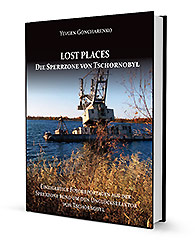 Afternoon December 23, 2011. Two hours on the road and from snowdrifts and ice of Regina Forest Resort, we again find ourselves in a warm autumn. The road crosses the western part of the Fukushima’s trace “horseshoe”. Gamma background level inside our van, reaching up to 1.5 µSv/h, gradually declining. We get into the territory of a moderate contamination. We entering Miharu and park in the centre of town near the town hall. On the street level of gamma background is about 0.3 µSv/h – almost clean...
Afternoon December 23, 2011. Two hours on the road and from snowdrifts and ice of Regina Forest Resort, we again find ourselves in a warm autumn. The road crosses the western part of the Fukushima’s trace “horseshoe”. Gamma background level inside our van, reaching up to 1.5 µSv/h, gradually declining. We get into the territory of a moderate contamination. We entering Miharu and park in the centre of town near the town hall. On the street level of gamma background is about 0.3 µSv/h – almost clean...
Miharu (三春町)
Miharu Town is on the island of Honshu, Fukushima Prefecture, Tamura District. The population is about 18 thousand inhabitants. Distance from the Fukushima-Daiichi Nuclear Power Plant is about 48 kilometres.

The name “Miharu” in Japanese (which by the way is clear from formed it kanji) means "three springs". Such a beautiful name arose from the fact that in most parts of Japan, plum, peach and cherry trees blossom at different times, but in Miharu they bloom almost simultaneously. Also Miharu known for one of the national treasure cherry trees of Japan – Miharu Takizakura (三春滝桜 – literally “Waterfall Cherry Tree of Miharu”). It's more than 1,000-year-old cherry tree, to see which people come from all over Japan. The tree is 12 meters high, the trunk circumference is 9.5 meters, from east to west branches spread up to 22 meters, and from north to south in 18 meters. This tree is in a list of five great sakuras of Japan and in the list of Japan's three giant sakuras. It is designated a national treasure in 1922. According to polls Miharu Takizakura often ranked as the most famous tree in Japan. About 300,000 people every year come to Miharu town to admire that sakura.
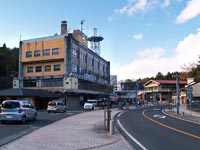 |
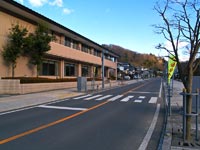 |
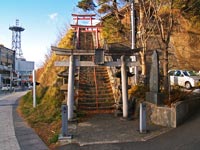 |
As I mentioned in the previous reportage, we have scheduled the meeting with the mayor of Miharu. There is still a little time before the scheduled meeting and I walk in the centre of town looking at the wrist indication device MKS-11 “Spectra”. The level of gamma background is in the range of 0.2-0.4 µSv/h, but once I get off the asphalt onto the lawn, the level grows up to 0.8 µSv/h.
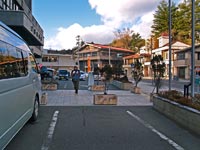 |
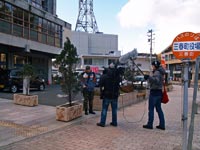 |
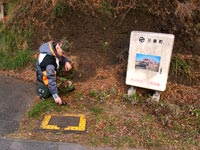 |
Quite unexpectedly in front of our group came an elderly man in a black jacket. Kenzo and Hori ran up to him, exchanged with standard Japanese bows-greetings and presented him to us: “Meet – Mr Yoshinori Suzuki, mayor of Miharu.”
Mayor of Miharu town Yoshinori Suzuki (铃木义孝) is known not only by the fact that from the first day of the accident at the NPP Fukushima-Daiichi he started to buy and distribute to local residents iodine drugs and dosimeters, but also by the fact that without waiting for advice and guidance of the central authorities he decided and carry out the decontamination of local schools, kindergartens and parks.
Mayor Yoshinori Suzuki is looking with interest at my devises. Without waiting for questions I begin to talk about levels of radiation which I just measured: “There is a slight excess, some spots come across, especially on the soil and even in front of city hall.” Yoshinori Suzuki shrugs with a smile: “Oh, it's not important. The main thing is that we cleaned the school! Come, I'll show you. It is more important to make measurements there.”
The school is located opposite the town hall on a small hill. We walk up the steep stairs, go through the wooden gate and find ourselves in the courtyard of a local school.
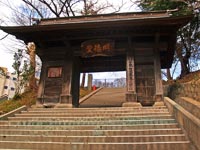 |
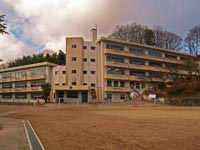 |
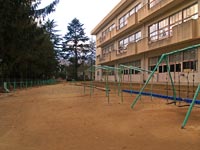 |
– We removed the entire top layer of soil and buried it in the backyard of the school, we also washed the walls and roof.
I measure the gamma background, as required, at a height of 1 meter from the ground: 0.16 µSv/h; on the surface of the ground level of beta – 15 disintegrations per square centimetre per minute. I can definitely say – the school yard is the cleanest place in Miharu.
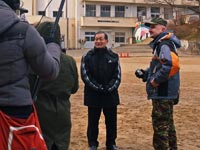 |
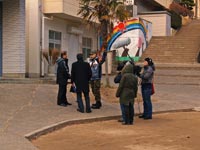 |
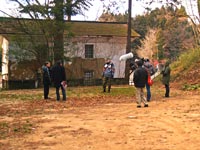 |
At the backyard there is an impromptu radioactive waste temporary localization site, where the top layer of soil from the school yard was buried (outside right photo). “What is the levels here?” I honestly admit: “0.5 µSv/h.” Yoshinori Suzuki frowning: “We do not let children come here, this is a temporary solution. Later we will take out the soil in a special repository for radioactive waste.” I'm in Japan only three days, but I am already clear understand that children will not come even close to here: because of unquestioned authority of adults. If adults told them to do not go there – no one will go. In any case, even if this radioactive waste temporary localization site is organized not exactly by the rules of radiation safety standards, it's better than everything would remain as is, and the children ran around the school yard, raising radioactive dust.
After finishing shooting in the school yard, we moved into the town hall, to the mayor’s office.
A short interview was protracted for two hours. Yoshinori Suzuki talks about the deactivation of the town; about the building of temporary housing for evacuees (Miharu sheltered about 1400 inhabitants of Tomioka and Katsurao); about lectures in schools about rules of radiation safety and radiation hygiene; constant monitoring of the gamma background and radioactive contamination in town, and more about many other serious issues. On the desk in the office there are boxes with potassium iodide and dosimeters. “This is my town and my people, they chose me, and they believe me. What is decided in Tokyo – I don't care too much. We went through so much, we will go through this as well.”
We say goodbye to the mayor of Miharu town Yoshinori Suzuki, and leave to Iwaki (いわき市 (磐城市). Iwaki is one of the central cities of Fukushima Prefecture, situated in 43 km on south of the Fukushima-Daiichi Nuclear Power Plant.
Tomorrow, December 24th, we will meet with local fishermen and a visit spectrometry laboratory.
| Hisanohama, Iwaki (いわき市). Fukushima Prefecture. Day Three< Prev | Next >Classmates. Fukushima Prefecture. The Second Day |
|---|









